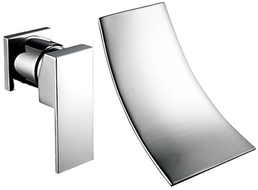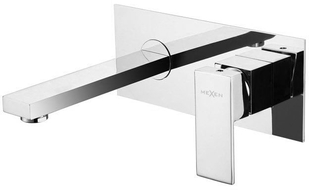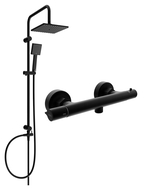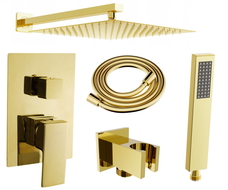
To chisel or not to chisel – that is the question! Everyone who plans to replace their bathroom tap faces this dilemma. Since the interior design trend in recent years is to hide fixtures, maybe it's worth chipping away the tiles and opting for a modern concealed tap? Then again… it's a shame about the tiles. They look good and might serve well for a long time. Perhaps sticking with the old, good exposed tap is the way to go? Before you decide, get to know the advantages of both solutions.
What will you learn from this article?
Are you preparing for a bathroom renovation or replacing fixtures? Or are you designing a new space? This article will help you understand the differences between the two most popular tap models. From the reading, you'll learn among other things:
how exposed and concealed taps differ and how they impact the look and functionality of the bathroom,
what makes the concealed tap take the sanitary fixture market by storm,
which solution to choose depending on the scope of renovation work,
what to pay attention to when choosing a tap to ensure it is durable, comfortable, and matches the style of the interior.
Exposed Basin Tap — Easy Installation
Wall taps are a solution most commonly found in classic bathrooms or interiors furnished a few years ago. Their biggest advantage is the installation method — the entire fixture is installed on a finished wall without the need for chiseling or major intervention in the room structure. It's a simple and practical choice. In case of a breakdown or need to replace a part, access to the mechanism is quick and hassle-free. The condition? The water installation must be routed in the wall — with pipes coming out at the right height above the sink. If so, the installation of exposed taps will go smoothly.
Do Exposed Taps Work in a Modern Bathroom?
Although concealed taps are currently very popular, exposed models haven't gone out of fashion. They are still eagerly chosen — and for good reason. Their advantage lies in the simplicity of assembly and significantly lower cost compared to systems hidden in the wall. Moreover, access to all tap elements makes it easier to keep them clean and make small repairs.
Exposed taps, mounted on the wall, don't take up space on the sink, providing more freedom during daily routines. The aesthetic appeal is noteworthy too — many old taps have styled handles and decorative spouts. Unusual shapes and a wide range of colors make them great even in modern, unique arrangements.
What Characterizes Modern Concealed Taps?
Concealed taps are a solution that requires a little more involvement — both in terms of planning and installation. To hide all installation elements and water supply pipes, it's necessary to carve channels in the wall. That's why installing a concealed tap, like the black Mexen Alma tap, is recommended in newly furnished bathrooms or during major renovations.
Fortunately, there's also a less invasive alternative. The whole system can be hidden under a plasterboard construction mounted on a steel frame. This solution is particularly good if you value minimalist design, and the bathroom space allows for free arrangement.
Tip! A black tap might be harder to maintain. See how to take care of it to keep its charm: how to clean washbasin taps?
From Basin to Shower — Which Tap to Choose for the Shower Area?
Now that we've discussed washbasin taps, let's move to another important bathroom area — the shower. Here too, there’s a dilemma: go for the classic exposed model or opt for a modern concealed shower tap? If you choose the latter, which concealed tap will be the best choice? Let's take a closer look.
Shower Tap — Better Exposed or Concealed?
In the case of exposed taps, we're dealing with a proven solution. It is mounted directly on the wall using existing connections. Whereas a concealed shower installation requires a bit more work since its heart is hidden under plaster or tiles. Only the control elements and spout remain visible, so the bathroom arrangement is tidy and aligns well with the idea of minimalism in interiors.
Concealed Shower Taps — For Aesthetics and Minimalism Lovers
If you're conducting a major renovation, you can replace an old exposed tap with one installed under the plaster. This solution is favored by those who want to completely modernize the shower. A concealed tap will make you not recognize your bathroom once the work is done.
The concealed shower set from Mexen impresses with its modern aesthetics — nothing protrudes, nothing disrupts the harmony of the interior. All wires, mixers, and connections are hidden in the wall, and on the outside, you only see stylish handles and the spout or rain shower. This way, the bathroom seems more orderly and spacious. Concealed models are available in various color options and offer many functionalities.
Concealed Shower Set with Rain Showerhead — Comfort You'll Love
A standard concealed tap consists of an external element and a concealed element. More advanced variants also include a rain showerhead installed in the ceiling or on an arm. This round or square panel showers the whole body with an even, gentle stream of water, making the shower more relaxing. If you also choose a set with a shower handle and function switch, you have full control over the shower.

Value the Classic? An Exposed Shower Tap Will Do Just Fine!
Exposed taps are still a very popular choice — and not just in older bathrooms. Their main advantage is easy installation: you attach them to the ready-made water outlets and the job is done. There's no need to chisel, design, or plan in advance. Maybe in your bathroom, a model like Mexen Fabia will work better?
Don’t worry that an exposed model will disrupt the minimalist look of the bathroom. Currently, you have a lot of shower taps to choose from — from classic chrome models to modern black, gold, or matte variants that fit very well with current interior design trends.
Shower Tap with Thermostat — Ideal Temperature Every Time
Are you choosing a concealed tap? Or are you tempted by an exposed tap with a rain showerhead? In both cases, you can invest in a version with a thermostat, which ensures the water always has the temperature you set — without jumps and sudden changes, even if someone else is turning on the water in the kitchen at the same time. It's an investment in safety, especially when children or the elderly use the shower. The thermostat is also a way to save money, as you set the right temperature faster, so you use less water.
Read more about thermostatic taps here: Shower tap with thermostat — when it might not be the best choice?
Exposed and Concealed Taps — What Are They Made Of?
Washbasin taps must be corrosion-resistant because they're constantly in contact with water. Therefore, modern fittings are most often made from brass coated with a layer of chrome or stainless steel. Chrome not only protects against rust but also increases scratch resistance, which translates to durability and aesthetic appearance.
Remember that chrome is just the outer layer. Before buying, check what the body is made of and how the inside of the tap looks — smooth walls and careful connections guarantee a steady, smooth stream of water and longer tap life.
The most important element of any fitting is the cartridge — preferably made of ceramic. The most durable models can withstand even a million cycles of opening and closing the flow. More and more manufacturers also care about the environment by equipping their taps with aerators — small attachments that aerate the stream and help reduce water consumption without sacrificing comfort.
Comparison of Pros and Cons of Exposed and Concealed Taps
Choosing a shower or washbasin tap isn't as straightforward as it might seem, so we've prepared a practical overview of both options:
Type of Tap | Exposed Tap | Concealed Tap |
|---|---|---|
Installation | No chiseling of plaster required for exposed tap installation | Requires cutting channels in the wall or frame before laying tiles |
Cost | Lower, cheaper installation | Higher, more labor-intensive installation |
Access | Easy, quick access to all elements | Hidden, requires chiseling walls |
Aesthetics | Entire fixture visible | Minimalist look, only handles and spout/rain shower visible |
Cleaning and Maintenance | Easy to keep clean, easy repairs | Easy to keep clean, requires dismantling for serious failures |
Application | Ideal for renovations without major intervention | Recommended for new installations and renovations |
Functionality | Various models available, including with thermostats | Wide range of advanced functions, e.g. function switches |
Impact on Bathroom Space | Does not reduce space on basin/shower | Aesthetically saves space and simplifies space |
Remember to choose taps from reputable manufacturers, made of high-quality materials (such as stainless steel) and properly protected against corrosion.
























